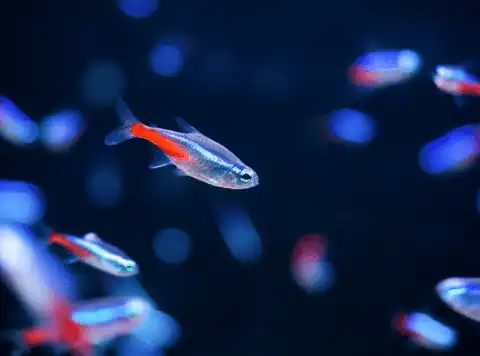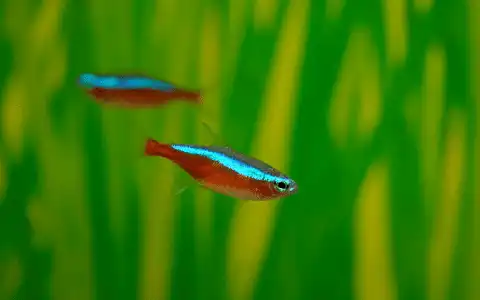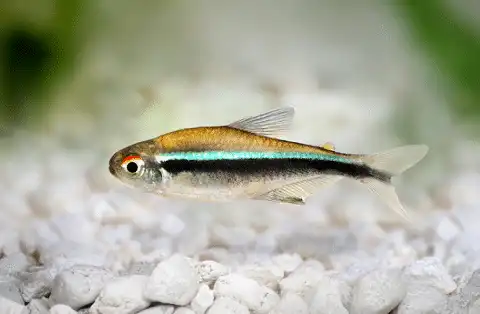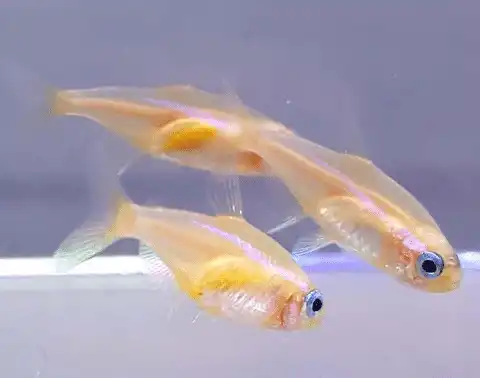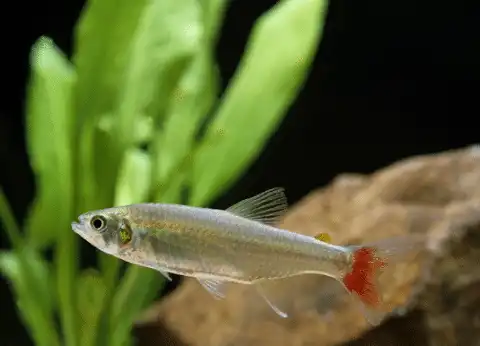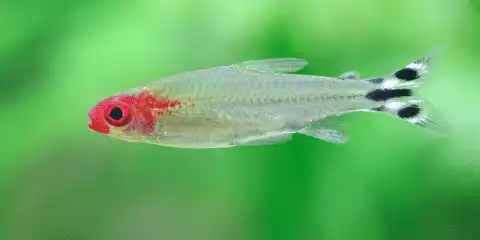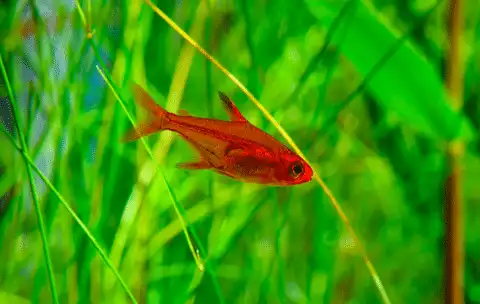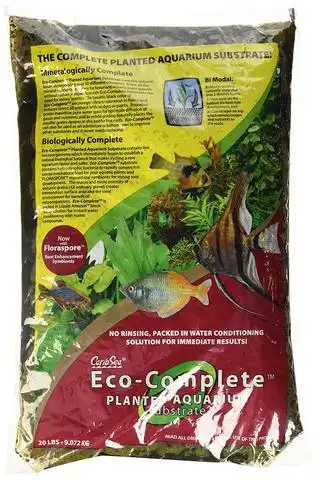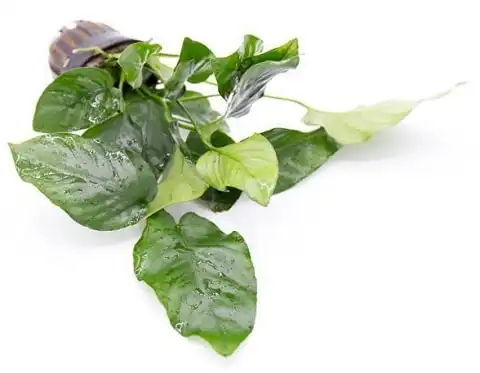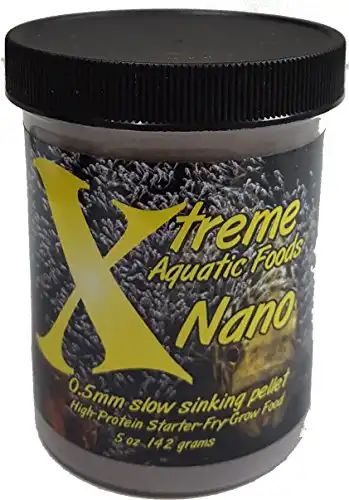Thank you for visiting! By the way… any links on this page that lead to products on Amazon and other stores/partners are affiliate links Aquarium Store Depot earns a commission if you make a purchase.
If you’ve ever been to a pet store, you’ve probably been amazed by schools of tiny neon-colored fish in their tanks- tetra fish. These small fish are easily one of the most popular choices for tropical freshwater aquariums.
You might not know just how many amazing different species are available in the aquarium hobby, so in this article, I’ll be introducing 21 terrific tropical tetras for your tank.
So let’s get started!
What Are Tetras?
Tetra fish are small freshwater schooling fish that are technically known as characiforms. Most types of tetras will reach a maximum size of between one and two inches long, although some, like the Congo tetra, can grow to over 3 inches.
Most of the tetras are from South America, but there are also great species from Africa. There is a huge variety of different tetra species in the aquarium hobby, with new species still being introduced from time to time.
Why Do They Make Such Great Aquarium Fish?
Tetras are beautiful fish. Most species have awesome colors and markings and some types of tetras also have interesting fin shapes. Looks are not all these tiny fish have going for them though, personality is just as important!
Tetra fish are a generally super peaceful species, that get along with just about any other tropical freshwater aquarium fish that isn’t big enough to eat them.
They also tend to be very hardy fish and easy to care for, although unfortunately, some tetras have lost their natural hardiness due to overbreeding.
21 Best Types of Tetras For Freshwater Aquariums
Now that you know a little more about tetra fish in general, it’s time to meet some of the best Tetra types for your aquarium. For each species, I’ll be providing you with some essential information like:
- Scientific Name
- Difficulty Level
- Temperament
- Adult Size
- Minimum Tank Size
- Diet
- Origin
- Temperature
- pH
- Difficulty to breed
- Planted aquarium suitability
Here is a video from our YouTube channel you can also follow. If you like our content, be sure to subscribe. We post new videos every week! We go into more detail in the blog post below.
Let’s get started!
1. Neon
Use Promo Code ASDFLIPPROMO
One of the most popular freshwater community schooling fish available in the aquarium trade. Great neon blue colors!
- Scientific Name: Paracheirodon innesi
- Difficulty Level: Easy
- Temperament: Peaceful
- Adult Size: 0.75-1.5 inches
- Minimum Tank Size: 15 gallons
- Diet: Mostly carnivorous
- Origin: Colombia, Peru, Brazil
- Temperature: 70-77°F
- pH: 4-7.5
- Difficulty to breed: Moderate
- Planted tanks: Yes
The Neon Tetra is a classic aquarium fish that has been popular aquarium fish for generations. These fish ‘wow’ everyone that sees them with their amazing colors. Neon Tetras are a schooling species and love to hang out together, so make sure you keep at least 8 of them in the same tank.
2. Cardinal
A very popular schooling fish. Looks like the Neon Tetra, but with longer blue and red stripes. Grows larger than a neon tetra as well
- Scientific Name: Paracheirodon axelrodi
- Difficulty Level: Moderate
- Temperament: Peaceful
- Adult Size: 1-1.5 inches
- Minimum Tank Size: 15 gallons
- Diet: Mostly carnivorous
- Origin: Brazil
- Temperature: 73-84°F
- pH: 3.5-7.5
- Difficulty to breed: Moderate
- Planted tanks: Yes
Cardinal Tetras might look very similar to the regular Neon Tetra but they are actually a completely different species. Cardinal Tetras also tend to be a little more difficult to find than regular neons. These schooling fish have even more color than Neon Tetras but the Cardinal Tetra grows a little larger.
3. Green Neon
- Scientific Name: Paracheirodon simulans
- Difficulty Level: Moderate
- Temperament: Peaceful
- Adult Size: 0.75-1 inch
- Minimum Tank Size: 10 gallons
- Diet: Mostly carnivorous
- Origin: Brazil
- Temperature: 76-90+°F
- pH: 3-6.5
- Difficulty to breed: Moderate
- Planted tanks: Yes
The Green Neon Tetra (Video Source) is another great species from the Neon Tetra group. Green Neon Tetras have a bright blue stripe running from head to the base of the tail which really makes them stand out in the tank. These fish are ideal for a heavily planted tank, as long as their tank mates are also very small and equally easy-going.
4. Black Neon
A variant neon variety. More reliant than neon and cardinal tetras
- Scientific Name: Hyphessobrycon herbertaxelrodi
- Difficulty Level: Easy
- Temperament: Peaceful
- Adult Size: 1.5 inches
- Minimum Tank Size: 20 gallons
- Diet: Mostly carnivorous
- Origin: Brazil
- Temperature: 68-82°F
- pH: 5-7.5
- Difficulty to breed: Moderate
- Planted tanks: Yes
Black Neon Tetras are a great alternative to the more common Neon Tetra. This species of tetra is widely available and a very peaceful community fish for heavily planted aquariums. Like most other tetras, these fish should not be kept with shrimps.
5. Gold Neon
A unique variant of the Neon Tetra. Looks amazing in aquascapes with red aquarium plants
- Scientific Name: Paracheirodon innesi
- Difficulty Level: Easy
- Temperament: Peaceful
- Adult Size: 0.75-1.5 inches
- Minimum Tank Size: 15 gallons
- Diet: Mostly carnivorous
- Origin: Colombia, Peru, Brazil
- Temperature: 70-77°F
- pH: 4-7.5
- Difficulty to breed: Moderate
- Planted tanks: Yes
If you think this fish looks a little familiar, that’s because it is actually the leucistic form of the regular Neon Tetra.
Both fish have the same care requirements, but the Gold Neon Tetra offers a completely different look. Gold Neon Tetras still have the neon stripe down the side of the body but a much lighter overall color.
6. Congo
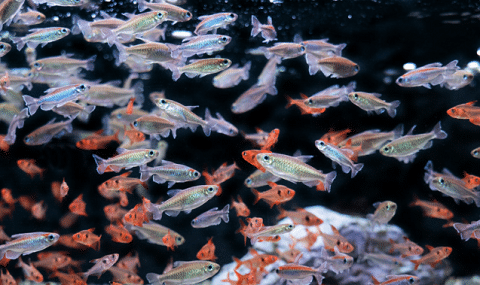
- Scientific Name: Phenacogrammus interruptus
- Difficulty Level: Moderate
- Temperament: Peaceful
- Adult Size: 2.5-3.5 inches
- Minimum Tank Size: 30 gallon
- Diet: Omnivorous
- Origin: Democratic Republic of Congo
- Temperature: 73-82°F
- pH: 6-7.5
- Difficulty to breed: Advanced
- Planted tanks: Yes
Although all the other tetra species on my list are from South America, the Congo Tetra (Phenacogrammus interruptus) just goes to show that Africa has some great tropical fish too! Congo Tetras have amazing colors, an interesting caudal fin, and a long, flowing dorsal fin.
Congo Tetras are large and very active, and they should only be kept in large groups and in tanks that have excellent water quality.
7. Bloodfin
Use Promo Code ASDFLIPPROMO
A great-looking nano fish with a reddish fin. Grows to 2 inches in length and fairly peaceful in nature
- Scientific Name: Aphyocharax anisitsi
- Difficulty Level: Easy
- Temperament: Semi-aggressive
- Adult Size: 2 inches
- Minimum Tank Size: 15 gallons
- Diet: Omnivorous
- Origin: Argentina, Brazil, Paraguay
- Temperature: 64-82°F
- pH: 6-8
- Difficulty to breed:
- Planted tanks: Yes
The Bloodfin Tetra (Aphyocharax anisitsi) is a very attractive fish, with sleek lines and a bright red tail fin. They are an easy tetra to care for and they do well with most tankmates in a tropical community aquarium. To be safe, just don’t keep them with slow-moving fish with long fins.
8. Rummy Nose
An easy to care for Tetra fish that loves to school. Very peaceful fish that are great for beginners
- Scientific Name: Hemigrammus rhodostomus
- Difficulty Level: Moderate
- Temperament: Peaceful
- Adult Size: 2 inches
- Minimum Tank Size: 20 gallons
- Diet: Omnivorous
- Origin: Brazil & Venezuela
- Temperature: 76-80°F
- pH: 5.5-7
- Difficulty to breed: Moderate
- Planted tanks: Optional
The Rummy Nose Tetra is a silvery fish with a black and white barred tail and a bright red face. They are a close shoaling species, so make sure you keep at least 10 to see them perform their natural behaviors.
The Rummy Nose Tetra makes a great community tank mate. It is best to keep them with other very peaceful types of tetras and community fish that will not bully smaller fish or outcompete them for food.
9. Black Skirt
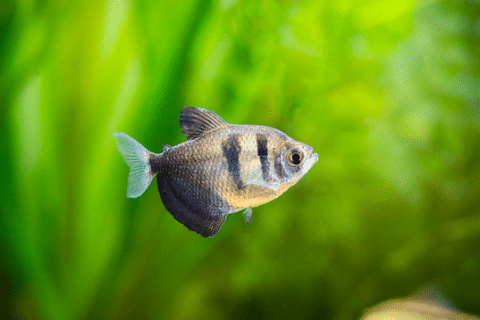
- Scientific Name: Gymnocorymbus ternetzi
- Difficulty Level: Easy
- Temperament: Peaceful
- Adult Size: 2.5 inches
- Minimum Tank Size: 20 gallons
- Diet: Omnivorous
- Origin: Argentina, Brazil, Bolivia
- Temperature: 68-78°F
- pH: 6-7
- Difficulty to breed: Moderate
- Planted tanks: Optional
Black Skirt Tetras are active fish that do great in community aquariums, especially if kept in a large group to prevent aggressive behavior. These fish are also known as the Black Widow Tetra.
It’s true that they are not the most colorful tetras, but they are still a fun and easy species to keep. There are also awesome varieties of Black Skirt Tetras available with longer fins or gold-colored bodies.
10. Black Phantom
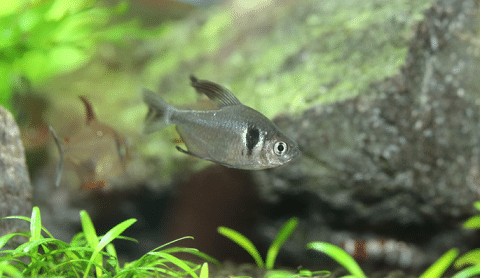
- Scientific Name: Hyphessobrycon megalopterus
- Difficulty Level: Easy
- Temperament: Peaceful
- Adult Size: 1.5 inches
- Minimum Tank Size: 20 gallons
- Diet: Omnivorous
- Origin: Bolivia & Brazil
- Temperature: 68-82°F
- pH: 5-7
- Difficulty to breed: Easy
- Planted tanks: Yes
The Black Phantom Tetra has a really bold look with its long black dorsal fin and dark body with a black marking just behind the gill covers. Like all tetras, these fish will do best in groups of at least 8 to 10 or so because this helps them feel more comfortable.
Black Phantom Tetras are very peaceful and easy to care for, making them a great choice for community tanks. Just be sure to avoid keeping them with shrimps or large aggressive tankmates to stay on the safe side.
11. Ember
A small red tetra that grows up to 1.25 inches. A very peaceful schooling fish
- Scientific Name: Hyphessobrycon amandae
- Difficulty Level: Easy
- Temperament: Peaceful
- Adult Size: 0.75 inches
- Minimum Tank Size: 10 gallon
- Diet: Carnivorous
- Origin: Brazil
- Temperature: 68-82°F
- pH: 5-7
- Difficulty to breed: Easy
- Planted tanks: Yes
The Ember Tetra (Hyphessobrycon amandae) is a nano freshwater fish species that can do well in pretty small aquariums. They are very peaceful fish that should only be kept with other small, non-aggressive species. Ember Tetras are schooling fish from South America that look amazing in a heavily planted aquarium.
12. Ruby
A small tetra that only grows to 1 inch in length. Very peaceful and does well in larger groups
- Scientific Name: Axelrodia riesei
- Difficulty Level: Moderate
- Temperament: Peaceful
- Adult Size: 0.75 inches
- Minimum Tank Size: 15 gallons
- Diet: Carnivorous
- Origin: Colombia
- Temperature: 68-82°F
- pH: 4-6.5
- Difficulty to breed: Moderate
- Planted tanks: Yes
The Ruby Tetra is quite similar in appearance to the Ember Tetra, but a lot less common (Video Source). What really sets these fish apart is their white fins, black tail spot, and awesome red eyes. Ruby Tetras are very small fish that are ideal for small aquariums in the 15-gallon range.
13. Bleeding Blue
- Scientific Name: Hyphessobrycon margitae
- Difficulty Level: Easy
- Temperament: Peaceful
- Adult Size: 2 inches
- Minimum Tank Size: 15 gallons
- Diet: Omnivorous
- Origin: Peru
- Temperature: 70-82°F
- pH: 5-8
- Difficulty to breed: Moderate
- Planted tanks: Yes
The Bleeding Blue Tetra (Video Source) is a less common relative of the Black Neon Tetra. These fish are larger tetras, and their amazing colors will make them stand out in any community aquarium.
Bleeding Blue Tetras are perfect for heavily planted aquariums but should not be kept with shrimps because they naturally feed on small invertebrates.
14. Purple
- Scientific Name: Hyphessobrycon metae
- Difficulty Level: Easy
- Temperament: Peaceful
- Adult Size: 1.5 inches
- Minimum Tank Size: 20 gallons
- Diet: Omnivorous
- Origin: Colombia & Venezuela
- Temperature: 68-82°F
- pH: 4-7
- Difficulty to breed: Moderate
- Planted tanks: Yes
The Purple Tetra is another awesome relative of the more common Black Neon Tetra (video source). These beautiful fish can be difficult to find, but make a perfect addition to any tropical community tank with other fish that are equally non-aggressive.
15. Golden Silver Tip
- Scientific Name: Hasemania nana
- Difficulty Level: Easy
- Temperament: Peaceful, Semi-aggressive
- Adult Size: 1.5-2 inches
- Minimum Tank Size: 20 gallons
- Diet: Omnivorous
- Origin: Brazil
- Temperature: 74-82°F
- pH: 6-8
- Difficulty to breed: Easy
- Planted tanks: Optional
This awesome variety of the regular Silvertip Tetra has a shining gold body that looks incredible in an aquarium with a dark background (video source).
Like regular Silvertip Tetras, you should only keep these schooling fish in a large group. Without a group to encourage their normal behaviors they may have a tendency to bully other fish and nip their fins.
16. Toucan
- Scientific Name: Tucanoichthys tucano
- Difficulty Level: Moderate
- Temperament: Peaceful
- Adult Size: 0.5-0.75 inches
- Minimum Tank Size: 10 gallons
- Diet: Carnivorous
- Origin: Brazil
- Temperature: 68-82°F
- pH: 4-6.5
- Difficulty to breed: Moderate
- Planted tanks: Optional
The Toucan Tetra is a great nano fish for tropical freshwater tanks. They have almost clear to golden bodies with a broad black stripe from head to tail and rosy-red cheeks (video source).
These tiny tetras are still a rare species in the aquarium hobby but are awesome tankmates for other nano fish like Otocinclus catfish and rasboras.
17. Orange Von Rio
- Scientific Name: Hyphessobrycon flammeus
- Difficulty Level: Easy
- Temperament: Peaceful
- Adult Size: 1 inch
- Minimum Tank Size: 15 gallons
- Diet: Omnivorous
- Origin: Brazil
- Temperature: 68-79°F
- pH: 5.5-7.5
- Difficulty to breed: Moderate
- Planted tanks: Yes
This fish is actually just an amazing orange strain of the popular Flame Tetra. These adaptable fish are easy to care for and make a great centerpiece fish with their eye-catching looks.
The Orange Von Rio Tetra is a very peaceful fish species that are perfect for community tanks, especially if they have other small, peaceful tankmates and live plants.
18. Blue
A mid and top-level dwelling tetra. Grows to 2 inches in size. Has a blue coloration on its back half under lighting
- Scientific Name: Boehlkea fredcochui
- Difficulty Level: Easy
- Temperament: Semi-aggressive
- Adult Size: 2 inches
- Minimum Tank Size: 2o gallons
- Diet: Omnivorous
- Origin: Peru
- Temperature: 72-82°F
- pH: 5.5-7.6
- Difficulty to breed: Moderate
- Planted tanks: Yes
Blue Tetras are still a pretty rare species but are amazing for larger community tanks. These guys can get a little feisty around feeding time, so make sure their tank mates are fast swimming and do not have long, soft fins.
19. Red Eye

- Scientific Name: Moenkhausia sanctaefilomenae
- Difficulty Level: Easy
- Temperament: Peaceful
- Adult Size: 2.5 inches
- Minimum Tank Size: 29 gallon
- Diet: Omnivorous
- Origin: Paraguay, Brazil, Argentina
- Temperature: 72-79°F
- pH: 6-8
- Difficulty to breed: Moderate
- Planted tanks: Yes
Red-eye Tetras can be identified by their shiny silver bodies, red eyes, and a black spot on their caudal fin (tail fin). It is important to keep them in a group of at least 8 fish to prevent fighting and fin nipping.
They are pretty big for tetras at over 2 inches in length and they are also very busy fish that swim actively in the aquarium. This means these guys need a bigger setup than the other species on this list.
20. GloFish

- Scientific Name: Gymnocorymbus ternetzi
- Difficulty Level: Easy
- Temperament: Peaceful
- Adult Size: 2.5 inches
- Minimum Tank Size: 20 gallons
- Diet: Omnivorous
- Origin: Argentina, Brazil, Bolivia
- Temperature: 68-78°F
- pH: 6-7
- Difficulty to breed: Moderate
- Planted tanks: Optional
The Glofish Tetra is a genetically modified version of the peaceful Black Skirt Tetra. Glofish are pretty controversial, and many aquarists either love them or hate them. One thing is for certain though, they do have incredible colors.
Glofish Tetras are pretty misunderstood in the hobby. These fish are not injected to give them these fluorescent colors, and they can be bred to produce equally colorful offspring.
21. Buenos Aires

- Scientific Name: Hyphessobrycon anisitsi
- Difficulty Level: Easy
- Temperament: Semi-aggressive
- Adult Size: 2 inches
- Minimum Tank Size: 20 gallons
- Diet: Omnivorous
- Origin: Uraguay, Paraguay, Brazil, Argentina
- Temperature: 64-82°F
- pH: 5.5-8.5
- Difficulty to breed: Moderate
- Planted tanks: Not recommended
The Buenos Aires Tetra is a great-looking fish with a silvery body and bright orange fins. These are large, active tetras, that can reach a little over 2 inches in length.
Buenos Aires Tetras have a bit of a reputation for eating aquarium plants, so they are not the best choice for carefully aquascaped aquariums. These fish are also not ideal for community tanks with smaller, slow-moving tank mates.
Additional Species
In case you’re still curious about even more types of tetra species, here are a few more that you might find swimming around at your local aquarium stores:
- Rainbow tetra
- Bleeding heart tetras
- Bucktooth tetras
- Emperor tetra
- Penguin tetras
- Lemon tetra
- Glowlight tetras
- Diamond tetras
- Serpae tetra
- Tail light tetra
- Mexican tetras
- Silvertip tetras
- Bleeding heart tetra
- Flame tetra
Tank Setup
Now that you’ve been introduced to some amazing tetra species for your aquarium, it’s time to learn how to care for them. Let’s start by looking at how to put together an awesome aquarium for your fish.
Aquarium Size
Most tetras are very small fish that don’t need a huge tank to be happy. They are active swimmers though, so they do need a decent amount of swimming space. The smallest species, like Ember Tetras, can be kept in tanks as small as 10 gallons. The majority of tetra species will do best in an aquarium size of 20 gallons or larger, however.
UNS offers a quality rimless aquarium at a great price. One of the big pure rimless aquarium brands you can purchase today!
Tetras are great fish for community tanks with other types of tetras or similarly sized tropical freshwater fish. If you want to set up a great community tank, make sure you provide enough room for the other fish too!
Substrate
The substrate is the sand or gravel that you put at the bottom of the tank. Some fish keepers prefer not to use any substrate at all, but I would recommend using aquarium gravel to create a more natural look in your tank. The color you use is not that important, but a darker substrate tend to bring out the colors in your fish better.
If you don’t want to work with an active aqua soil, but still want some of the advantages of one, you can try a product like CaribSea Eco Complete. It’s a beginner friendly inert substrate that will absorb aquarium fertilizers well.
Budget Option
A beginner friendly, inert substrate that is great for beginners starting their first planted tanks
Lighting
Many tetras prefer pretty dim lighting, so you don’t need anything too powerful or expensive to keep these fish happy. Unless you plan on growing a lot of live plants, a standard aquarium light will do just fine. For planted tanks, consider a light designed for them.
Filtration
An aquarium filter is a piece of hardware that aquarists use to keep the water in the fish tank clean and healthy. Filters do some very important things like:
- Mechanical filtration
Mechanical filtration is the actual physical removal of waste particles from the water. Essentially, aquarium filters suck water through a sponge-like material and these solid particles get trapped, leaving clean water to flow through the other side.
- Biological filtration
This is the incredibly important type of filtration where beneficial bacteria that live in your aquarium filter work to convert dangerous ammonia and nitrites into nitrate, which is safer for your fish.
- Chemical filtration
Many modern aquarium filters now offer a third type of filtration that removes toxins from the water. Often these filters use a material known as activated carbon that attracts and absorbs certain harmful particles.
There are many different types of filters available, so it can be tough to choose the best one for your tank. A great starting point for a tetra tank or community setup would be a simple hang-on-back or internal power filter.
The Best Aquarium Power Filter
The worlds best selling and most reliable power filter on the market. Unchanged for years because it's so reliable and versatile
Testing Water Parameters
Water parameters are the conditions of your tank water. Different fish species prefer different parameters, so it’s important to look up the preferred conditions for each type of fish you keep.
The water you use in your aquarium will have certain qualities before you add it to the tank, and will also change over time, so it’s important to be able to test your water.
Testing your water parameters is easy with a test kit. There are a few different types of these test kits, ranging from dry strips that you dip in the water, to liquids that you add drops of your aquarium water to. If water chemistry isn’t your favorite subject, don’t worry, they are very easy to use.
Although each different tetra species has its own range of preferred parameters, let’s take a look at a generalized set of conditions that will work for most tetras:
- Temperature: 76°F
- pH: Most tetras do best in slightly acidic water, so a pH of between 6 and 6.5 is ideal.
- Ammonia: 0ppm. Ammonia is a toxic substance produced in fish waste. In a cycled aquarium, testing should show no ammonia.
- Nitrite: 0ppm. Nitrite is a toxic substance produced in fish waste. In a cycled aquarium, testing should show no nitrite.
- Nitrate: 1-20 ppm.
Live Plants
Growing live plants in your aquarium is a subject all on its own, but it’s easier than you might think! Live plants provide many awesome benefits to your fish like:
- Creating structure and hiding places
- Providing a more natural habitat
- Providing a growing surface for natural foods
- Oxygenating the water
- Removing nitrates from the water
Most tetras do great in planted tanks, and I would recommend the following species for beginners because they are easy, tough, and grow well in low light.
Hardy, forgiving and easy to grow. The Anubias Nana is your ticket to the incredible hobby that is aquascaping!
If you have bright lighting, growing some floating plants like Amazon Frogbit can create some shady spots. This can help make your fish more comfortable and bring out their natural behaviors.
Unlike other tetras, the Buenos Aires Tetra has a bit of a reputation as a plant-eater. This is one tetra species I would not recommend for planted tanks unless you don’t mind them taking a bite here and there.
Decorations
Natural decorations are the best to purchase to simulate their natural environment. Try purchasing decorations like aquarium driftwood and rocks. For driftwood, easy to use manzanita or spiderwood work very well and shape well for attaching plants to it.
Editor's Choice
Manzanita offers it all. Great shape, low tannins, quick to water log and reasonably priced. It's the ultimate driftwood!
For rocks, consider rocks like dragon stone or Seiryu stone. These rocks are great to use for aquascaping styles like Iwagumi.
How To Care For Them
Tetras are low-maintenance fish that are really easy to care for. That’s why many tetra species make such great fish for beginners. Let’s go through some of the basics of tetra care:
Aquarium maintenance
To keep your fish healthy and looking their best, regular aquarium maintenance is necessary. The most important thing you can do is to perform regular partial water changes.
This means regularly removing a certain proportion of the water and replacing it with fresh new water. A good starting point would be a 25% weekly water change.
Apart from your water changes, you’ll need to rinse out your filter media when it becomes clogged up and clean any algae that may build up on the glass or other surfaces on your tank.
Behavior
In their natural habitat, tetras are schooling and shoaling fish. This means they live in large groups of their own species out in the wild. You may even find groups of tetras schooling with other tetra species.
Tetras on their own or in very small groups will be stressed and nervous, and not comfortable enough to behave in their natural ways. Although tetras are peaceful fish species, some types may even become aggressive, so you should always keep your tetras in a good size group of the same species.
In most cases, the minimum group size for tetras is 8-10 of the same species, but you can go even bigger than that!
Tank Mates
If you plan on setting up a community tank, it’s important to know which species make ideal tank mates and which don’t. Tetras are small fish, so make sure their tank mates aren’t big enough to swallow them!
Tetras themselves are often partially or completely carnivorous, so avoid keeping them with fry or small shrimps that they may feed on. Here’s a short list of possible fish species that you can keep with your tetras:
- Danios
- Dwarf cichlids from South America
- Otocinclus Catfish
- Corydoras Catfish
- Pencilfish
- Dwarf Gourami Fish
- Other types of tetras
Avoid purchasing aggressive freshwater fish such as:
- Oscars
- Jack Dempsey
- Jaguar Cichlid
- African cichlids
Feeding
Most tetra species are omnivorous which means they need both plant and animal matter in their diets. As a general day-to-day food, flakes or micropellets are a fine choice to keep your tetras well fed. Instead of choosing the cheapest variety available, make sure you pick up a high-quality, balanced product like Xtreme Aquatic Foods.
Xtreme Aquatics Nano formula is specially designed for smaller fish and contained a well balance mix of raw ingredients. It is a great staple food for your nano fish.
While this food source is a good staple diet, you should always supplement their diet with natural foods as this will bring out the best color and behavior in your fish. You can provide natural foods in either live or frozen form.
Let’s take a look at some great natural foods that you can provide:
- Brine shrimp
- Blood worm
- Mosquito larvae
- Micro worms
Breeding
Many tetras are easy to breed, and sometimes they don’t need any help at all. To encourage your tetras to breed, be sure to provide them with high-quality natural foods and excellent water quality. If you have a large, mature aquarium, you might wake up one day to find tiny new fish swimming around!
Usually, however, the problem with breeding tetras is that they tend to eat their eggs and fry, so you need to take some steps to get them to breed in the first place, and then to keep the eggs and babies safe.
To do this, you will need to set up a specific breeding tank. A small tank of just a few gallons, and with no substrate is usually used for this. A clump of java moss in the tank will give the female a place to lay her eggs.
Add an egg-carrying female to the tank and then two days later, a male. Perform a large water change in the evening with cooler water, this imitates the start of the rainy season. After the water change, cover up the tank to keep it in complete darkness until the following day.
Remove the cover and switch on the lights, this often stimulates the pair to spawn. If the fish lay eggs, move them back to their regular tank and congratulate yourself on breeding your tetras!
Where to Buy
Tetras are some of the most common aquarium fish in the hobby and are usually pretty easy to find at your local fish store. My favorite online store for tetras is definitely Flipaquatics.
These guys stock an awesome range of tetra species and take amazing care of their fish, even offering a 100% live arrival guarantee on certain deliveries! They also quarantine all their livestock!
FAQS
How many of them should be kept together?
Tetras are schooling and shoaling fish that need to be kept in groups to feel comfortable in your tank. I would recommend keeping a group of at least 8 tetras of the same species.
Are they easy to care for?
Most tetras are very easy to care for, and that makes them great beginner fish. Tetras will thrive as long as they are kept in a stable, heated aquarium, with good filtration and the right water parameters.
Do they need a heater?
Most tetras are tropical fish that need water temperatures between about 68 and 76°F, depending on their species, of course. If you live in a tropical area where the water naturally stays in this range, a heater will not be necessary.
I recommend using a heater in all cases, however, just because it makes it so much easier to maintain stable conditions.
What is the best kind?
If you ask 10 different people this question, you could get 10 different answers! The best type of tetra for any fishkeeper is the one that most appeals to them, and the one that they can provide the right care for.
What is the most common?
The regular Neon Tetra is the most common tetra available. This is not surprising though because these awesome fish look great, are very peaceful, and are also very easy to care for.
What is the most peaceful?
Most tetras tend to be pretty peaceful. The most popular tetras like cardinal, neon, and rummy nose tetras are some of the most peace fish you can purchase in the hobby.
Final Thoughts
With so many awesome types of tetras available in the hobby, there’s a great option for just about any tank. To be honest, the most difficult part of keeping tetras is choosing which species you like best! I hope this article helps make your choice a little easier, and with this information, you should have no problem setting up the perfect tank for them too.
Which is your favorite tetra species? Leave a comment below and let’s start a conversation! Thank you for visiting and reading!
- About the Author
- Latest Posts
I’m thrilled that you found Aquarium Store Depot! Here you’ll find information on fish, aquariums, and all things aquatics related. I’m a hobbyist (being doing this since I was 11) and here to help other hobbyists thrive with their aquariums! I adhere to a high quality Editorial Process and Review products with real life field usage and practical analysis.


